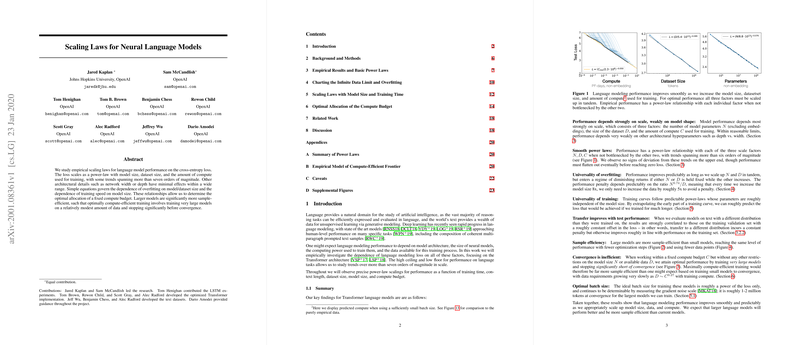Background and Methodology
The research presents an empirical investigation into the relationship between LLMing performance and multiple factors, including model size, dataset size, and training compute. The paper harnesses the Transformer architecture, considering its aptness for tasks requiring different levels of performance. A fundamental observation is that performance enhancements typically follow power-law trends relative to each of these factors, provided no bottleneck from the others. Crucially, these relationships span across more than seven orders of magnitude, indicating robust patterns even at varying scales.
Key Findings
The paper provides several compelling findings:
- Models' performance is predominantly dictated by scale—number of parameters (N), dataset size (D), and training compute (C)—and only weakly by other hyperparameters such as architecture depth and width.
- A smooth power-law relationship is observed with individual scale factors when the other two are not limiting.
- To avoid overfitting penalties, data and model size must scale synergistically. Notably, when model size is increased by a factor of eight, data needs only a five-fold increase.
- Training efficiency reflects predictable power-law trends, virtually independent of model size. Models can be trained faster, with fewer data points, by extrapolating early trends.
Furthermore, models with different distributions generalize better as performance on the training set improves, and large models are inherently more sample-efficient.
Compute Budget Optimization
A key contribution of the paper is the guidance on optimal allocation of a fixed compute budget. Efficacy here invloves training extremely large models on modest data amounts and stopping well before full convergence. These large models are significantly more sample-efficient, requiring fewer optimization steps, which can be counterintuitive when conventionally smaller models are trained to completion. With growing computational budgets, the primary focus should be on upscaling model size, with modest boosts in dataset size and only marginal increases in serial training time.
Predictive Framework and Implications
The researchers provide equations portraying the empirical relationships discovered, akin to a "statistical mechanics" for LLMs. These laws predict how the optimal model size, batch size, steps taken, and required dataset size should scale with a given computational budget, shedding light on how advancements in LLMing are likely to evolve as resources expand.
Potential Limitations
The paper discusses potential caveats, such as the lack of a solid theoretical underpinning for the empirical scaling laws and questions on how generalizable these trends are across different domains or types of models. The paper’s predictions are also not verified in the extremely large data or model size regime, thus leaving some uncertainties on their long-term applicability.
Conclusion
In essence, this research contributes significantly to understanding how LLMs scale and provides practical recommendations for efficient training. It suggests that future improvements in AI language understanding are not just tied to the availability of data, but also hinge critically on the strategic deployment of computational resources and model design. The findings indicate a path where larger, more computationally demanding models, if trained judiciously, could yield substantial gains in performance.
